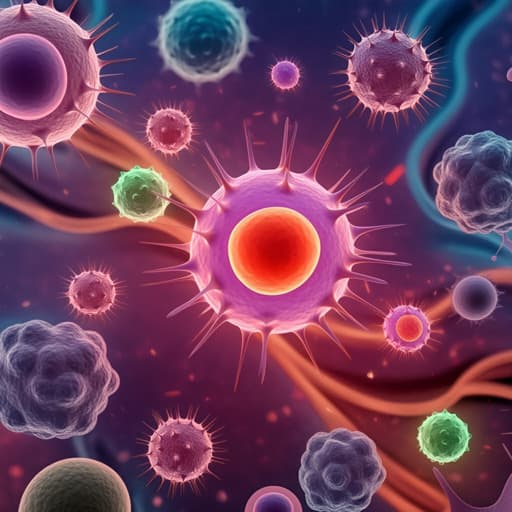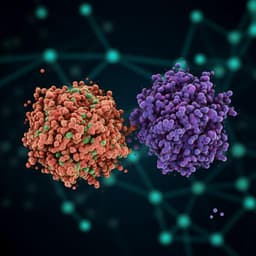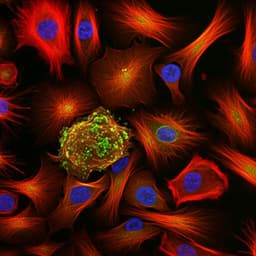
Biology
Biology of Circulating Tumor Cells through Single-Cell RNA Sequencing: Implications for Precision Medicine in Cancer
S. Orrapin, P. Thongkumkoon, et al.
Discover how circulating tumor cells (CTCs) are reshaping our understanding of cancer metastasis through cutting-edge single-cell RNA sequencing. This review, conducted by Santhasiri Orrapin, Patcharawadee Thongkumkoon, Sasimol Udomruk, Sutpirat Moonmuang, Songphon Sutthitthasakul, Dumnoensun Pruksakorn, and Parunya Chaiyawat, explores intricate CTC interactions and potential therapeutic pathways.
~3 min • Beginner • English
Introduction
The review addresses how circulating tumor cells (CTCs) drive hematogenous metastasis and survive the hostile bloodstream microenvironment, undergoing epithelial–mesenchymal transition (EMT) and mesenchymal–epithelial transition (MET) to disseminate and colonize distant sites. Given the extreme rarity, heterogeneity, and phenotypic plasticity of CTCs, there is a need for high-resolution technologies to unravel their biology and interactions with blood components. Single-cell RNA sequencing (scRNA-seq) enables genotypic and phenotypic characterization of individual CTCs, revealing mechanisms of dissemination, survival, immune evasion, and therapeutic resistance. The purpose of this review is to summarize workflows for CTC enrichment and single-cell isolation compatible with scRNA-seq, outline bioinformatic analyses for single-cell data, and synthesize translational insights linking CTC transcriptomes to prognosis, treatment response, and potential therapeutic targets for precision medicine.
Literature Review
The article synthesizes current literature across three major domains: (1) CTC enrichment and single-cell isolation methods compatible with scRNA-seq, including immunoaffinity-based EpCAM platforms (e.g., CellSearch, CTC-Chip, NanoVelcro), non-EpCAM strategies (negative selection, size-based systems like ISET and microcavity arrays), and integrated systems (MagSweeper, RosetteSep, dual-filtration). Post-enrichment single-cell retrieval approaches reviewed include limiting dilution, FACS, micromanipulation (CellCollector, CytePicker, SASCA), laser capture microdissection (LCM, including NanoVelcro-LCM), and microfluidic single-cell systems (10x Genomics, Hydro-Seq, SCR-chip, optofluidic sorters). (2) Computational analysis for scRNA-seq of CTCs: methods for dimensionality reduction and clustering (PCA, t-SNE, UMAP; deep-learning based scCAEs, scDeepCluster, scVI, DCA, DESC), differential gene expression (bulk-derived tools versus single-cell-tailored tools such as MAST, Monocle, BPSC, DEsingle), and trajectory/pseudotime inference (Monocle 2/3, Palantir, Slingshot, PAGA, STREAM, Tempora, tradeSeq). Specialized methods tailored to rare CTC analysis are highlighted (e.g., DDLK, SCENT signaling entropy, pathway-level aggregation). (3) Translational findings from scRNA-seq of CTCs across cancers: prognostic and predictive signatures (EMT/MET phenotypes, CSC markers), therapy response markers (pre-adapted states; ER-driven resistance signatures in breast cancer), metastatic pathways (ECM program and SPARC in pancreatic CTCs; CCL5-mediated Treg recruitment in HCC), and resistance mechanisms (non-canonical WNT signaling in antiandrogen-resistant prostate cancer). Additional studies on CTCs/DTCs in other body fluids (CSF, pleural effusions) reveal site-specific transcriptomes and further heterogeneity.
Methodology
As a review, the paper outlines methodological workflows rather than conducting a new experimental study. Key methodological components summarized include: (1) CTC enrichment strategies: EpCAM-based immunocapture (CellSearch, CTC-Chip, NanoVelcro), non-EpCAM approaches (negative depletion using RosetteSep/Leucosep CD45− selection; size-based filtration such as ISET and microcavity arrays; density gradients), and integrated high-recovery platforms. Capture efficiencies and counts from representative studies are provided for breast, colorectal, lung, and hepatocellular carcinoma cohorts. (2) Single-cell isolation compatible with downstream scRNA-seq: FACS after enrichment (requires sufficient input cells; potential WBC carryover), micromanipulation via automated platforms (CellCollector functionalized wires, RareCyte/CytePicker, SASCA semi-automated aspirator), laser capture microdissection (LCM and NanoVelcro-LCM), and microfluidic single-cell systems (10x Genomics droplet-based, Hydro-Seq with valve controls, SCR-chip integrating screening and SMART-Seq II, and in vivo optofluidic sorters for mouse models). Reported performances include high single-cell purity (>90%) for micromanipulation/LCM and high capture efficiency for Hydro-Seq (≈73%); droplet systems can lose ~50% of input cells, which is critical given CTC rarity. (3) scRNA-seq data processing: standard single-cell pipelines for quality control, normalization, dimensionality reduction and clustering (PCA, t-SNE, UMAP; deep learning models), DGE analyses (MAST, Monocle, BPSC, DEsingle; comparisons with DESeq2/edgeR/limma), and trajectory/pseudotime inference (Monocle 2/3, Palantir, Slingshot, PAGA, STREAM, Tempora, tradeSeq). Custom CTC-focused analytics include pathway-centric aggregation methods and signaling entropy (SCENT) to assess differentiation potency and drug resistance phenotypes. (4) Validation modalities: integration with genomic assays (WES/WGS/Sanger), functional perturbations (e.g., SPARC knockdown), interactome analyses (CTC–platelet/immune cell crosstalk), and translational correlation with clinical outcomes, risk scores, and drug sensitivity models (CTC cultures, xenografts, and organoids).
Key Findings
- Enrichment and single-cell isolation performance: Hydro-Seq achieved CTC capture efficiency of 72.85 ± 2.64% with low leukocyte contamination; droplet-based 10x platforms recovered 30–60% of input cells (≈50% loss), challenging for rare CTCs; integrated microfluidic and LCM/micromanipulation approaches enable >90% purity and compatibility with WGS/WES and scRNA-seq.
- Bioinformatics: Nonlinear embeddings (t-SNE, UMAP) outperform PCA for visualization of noisy, sparse scRNA-seq; deep-learning methods (scVI, DCA, DESC, scCAEs) improve denoising, batch correction, and clustering. Single-cell-specific DGE tools (MAST, Monocle, BPSC, DEsingle) show varying sensitivity and false-positive rates depending on expression levels and dataset properties.
- Prognostic markers and subtyping: EMT/MET and CSC phenotypes within CTCs correlate with poor outcomes across cancers. In breast cancer, Hydro-Seq detected HER2+ and HER2− CTCs with EMT/MET programs and rare CSC-like subpopulations (ALDH; CD44+/CD24−). In colorectal cancer, mesenchymal CTCs (VIM, SPARC, ITGB1) predict worse PFS/OS; in advanced HCC, EMT/stemness gene upregulation (VIM, ROM1, POU5F1, NOTCH1, STAT3) associates with poor prognosis.
- Treatment response and resistance: A pre-adapted (PA) transcriptional state in breast CTCs indicates a quiescent, therapy-resistant subpopulation; a 6-gene ER-related resistance signature (PIP, SERPINA3, AGR2, SCGB2A1, EFHD1, WFDC2) predicts rapid progression. A broader 18-gene prognosis panel and risk score link high-risk CTC profiles to activation of AKT–mTOR and CDK pathways and sensitivity to corresponding inhibitors.
- Prostate cancer CTCs: High SPINK1 and BIRC5 (survivin) levels associate with aggressive subtypes and castration resistance; an 11-gene RRM2 signature is enriched in enzalutamide-resistant CTCs and correlates with poor outcomes; EphB2/Src pathway upregulation contributes to metastatic phenotypes.
- Site-specific CTC/DTC profiling: CSF-CTCs in LUAD show high lung/epithelial/proliferation gene expression with ECM upregulation; DTCs in pleural effusions stratify into immune, proliferation, apoptosis, and adhesion programs.
- Metastatic mechanisms: Pancreatic CTCs overexpress ECM genes, notably SPARC; SPARC knockdown reduces invasion/metastasis in vivo. In HCC, CTCs adapt during circulation with stress, cell-cycle, and immune evasion programs; CCL5 mediates recruitment of regulatory T cells via p38–MAX–CCL5 signaling, promoting metastasis.
- Drug resistance mechanisms: Non-canonical WNT (e.g., WNT5A) is induced in prostate CTCs under AR-targeted therapy, diminishing anti-proliferative effects; combinatorial targeting of canonical and non-canonical WNT may counter CSC-driven resistance.
- Therapeutic implications: Potential targets include EMT markers (N-cadherin, vimentin), survival/anoikis pathways (TrkB, PI3K), platelet–CTC interactions (anti-platelet strategies, integrin αVβ3), and immune checkpoints (PD-1/PD-L1, CTLA-4). CTC-derived cultures and organoids across several cancers enable ex vivo drug testing and correlate with clinical responses.
Discussion
The review demonstrates that scRNA-seq of individual CTCs can disentangle intratumoral heterogeneity, EMT plasticity, and dynamic adaptations to circulatory stress and therapy, directly addressing the challenge of understanding which CTCs seed metastases. By integrating sensitive enrichment/isolation platforms with advanced single-cell analytics, investigators can identify prognostic and predictive signatures, resolve rare subpopulations (e.g., EMT–CSC hybrids, pre-adapted resistant cells), and reveal actionable pathways (ECM–SPARC, WNT signaling, AKT–mTOR/CDK activation, CCL5–Treg axis, PD-1/PD-L1 immune evasion). These insights support precision oncology strategies: risk stratification, early treatment-response monitoring, and rational selection of targeted or immunotherapies. Furthermore, scRNA-seq exposes CTC interactions with platelets and immune cells, highlighting microenvironmental crosstalk that can be therapeutically modulated. Despite methodological advances, the rarity of CTCs, technical noise, and batch effects in scRNA-seq necessitate tailored computational methods and standardized pipelines, particularly for detecting rare clusters and lowly expressed genes. Overall, scRNA-seq of CTCs bridges liquid biopsy with functional tumor biology, enabling minimally invasive, longitudinal monitoring and individualized therapy design.
Conclusion
This review consolidates current technologies and bioinformatic approaches for enriching, isolating, and profiling single CTCs and synthesizes translational findings linking CTC transcriptomes to prognosis, therapeutic resistance, and metastatic mechanisms. Key contributions include outlining practical workflows (enrichment, single-cell isolation, scRNA-seq analysis), highlighting high-performing platforms (e.g., Hydro-Seq, LCM/micromanipulation), and curating evidence for clinically relevant CTC signatures and druggable pathways (ECM/SPARC, WNT, AKT–mTOR/CDK, CCL5–Treg, PD-1/PD-L1). Future directions emphasize improving capture efficiency and purity for ultra-rare CTCs, enhancing sequencing fidelity, and standardizing scalable, automated analyses. Integration with functional models (CTC cultures, patient-derived organoids, xenografts) and multi-omic/spatial technologies is expected to accelerate personalized therapy selection and metastasis prevention.
Limitations
The authors note several challenges limiting clinical translation: low capture efficiency and recovery of extremely rare CTCs; potential lack of true single-cell resolution and contamination with leukocytes; variability across enrichment platforms (e.g., substantial cell loss in droplet systems); technical noise, batch effects, dropout, and sparsity in scRNA-seq; lack of standardized, automated pipelines optimized for rare-cell analysis; labor-intensive workflows and high costs; and limited scalability for multi-sample studies. Many commonly used scRNA-seq analytical tools were not designed specifically for rare CTC populations, impacting sensitivity to lowly expressed genes and rare clusters.
Related Publications
Explore these studies to deepen your understanding of the subject.







